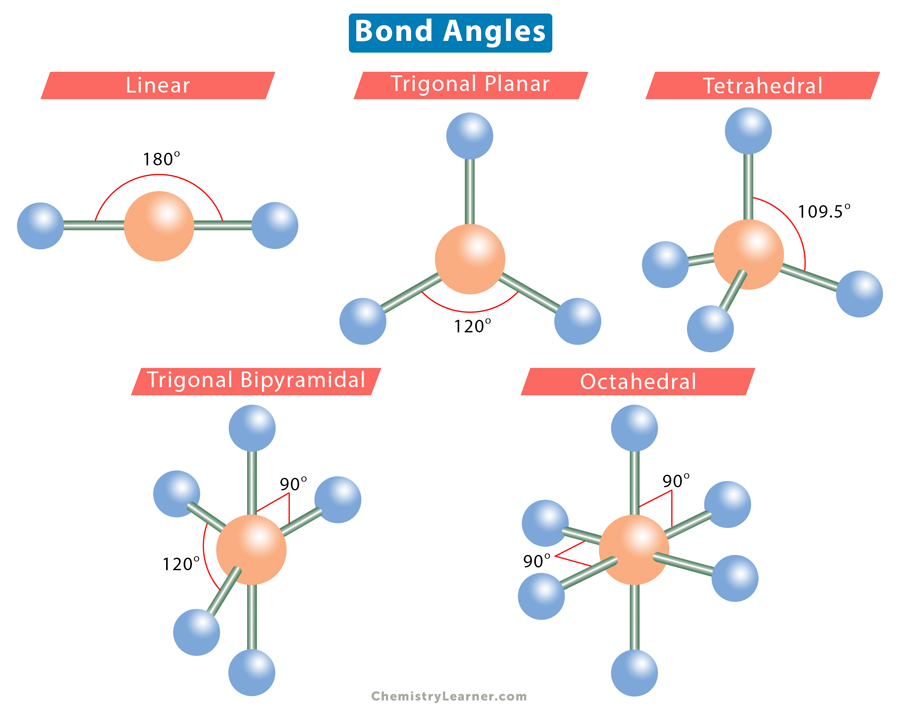Bond Angles
In our article on molecular geometry, we discovered how atoms are arranged in a molecule in a two- or three-dimensional structure. A molecule consists of a central atom chemically bonded to several side atoms. The bond angle is the angle between any two adjacent bonds and is usually measured in degrees [1-4].
Bond Angles and VSEPR Theory
The valence shell electron pair repulsion (VSEPR) theory is used to study bond angles. This theory predicts a molecule’s shape based on the number of bonding and lone pairs. According to this theory, the lone pairs in the valence shell of the central atom will rearrange themselves to minimize the repulsion and maximize the distance between them. As a result, the molecule forms a regular geometric shape. The angle between the adjacent bonds defines the bond angle [1-5].
Bond Angles and Molecular Shape
The VSEPR theory predicts five fundamental shapes of molecules with no lone pairs. Bond angles can distinguish these five shapes, as shown in the table below [1-5].
| Molecular Shape | Bond Angle | Examples |
|---|---|---|
| Linear | 180° | BeF2, CO2, HCN, C2H2, N3–, SCN–, NO2+ |
| Trigonal Planar | 120° | BF3, H2CO, COCl2, SO3, NO3– CO32– |
| Tetrahedral | 109.5° | CH4, XeO4, ClO4–, SO42-, PO43–, NH4+ |
| Trigonal Bipyramidal | 90°, 120° | PF5, PCl5, Fe(Co)5 |
| Octahedral or square bipyramidal | 90°, 90° | SF6, Mo(CO)6 |
Effect of Lone Pairs on Bond Angle
Lone pairs of electrons on the central atom affect the molecular shape. The lone pairs are located in the atomic orbitals of the central atom and repel the bond pairs, causing a deviation from the abovementioned geometry. Therefore, the bond angles of some molecules depend on the number of lone pairs [6].
Let us consider the tetragonal shape to understand this effect. Four electron pairs (bonding and nonbonding) are required to define a tetrahedral-shaped molecule whose standard bond angle is 109.5°. Let us see how the shape changes from methane to ammonia to water.
- Methane (CH4) consists of all bond pairs. There are no lone pairs in methane. Therefore, its shape is tetrahedral with a standard bond angle of 109.5°.
- Ammonia (NH3) consists of three bond pairs and one lone pair. The lone pair will push the bond pairs outwards, reducing the bond angle to 107°. The resultant molecular shape is trigonal pyramidal.
- Water (H2O) has two bond pairs and two lone pairs. The two lone pairs will repel the bond pairs further, thereby reducing the bond angle to 104.5°. The overall shape of the molecule is bent or angular.
The following chart shows the ideal and observed bond angles for different molecular shapes when lone pairs are introduced into the basic shape [1-5].
| Basic Geometry 0 Lone Pair | 1 Lone Pair | 2 Lone Pairs | 3 Lone Pairs | 4 Lone Pairs |
|---|---|---|---|---|
| Linear 180° | ||||
| Trigonal Planer 120° | Angular or bent 120° | |||
| Tetrahedral 109.5° | Trigonal Pyramidal 109.5° (107° in NH3) | Bent or Angular 109.5° (104.5° in water) | ||
| Trigonal Bipyramidal 90°, 120° | Seesaw ax-ax 180° (173.1° in SF4) eq-eq 120° (101.6° in SF4) ax-eq 90° | T-shaped 90° (87.5° in ClF3), 180° (175° in ClF3) | Linear 180° | |
| Octahedral 90°, 90° | Square Pyramidal 90° (84.8 in BrF5) | Square Planar 90° | T-shaped 90°, 180° | Linear 180° |





